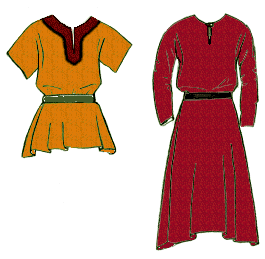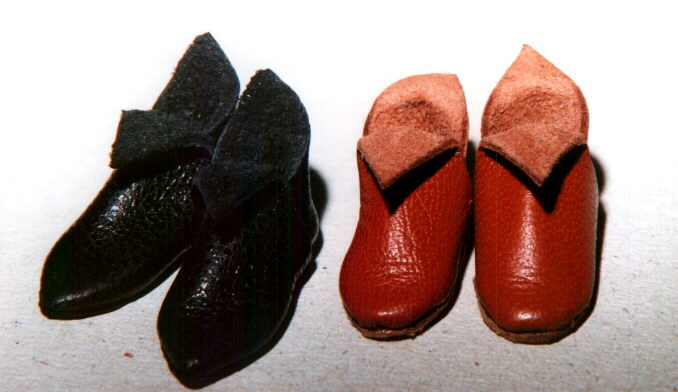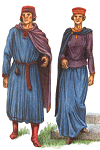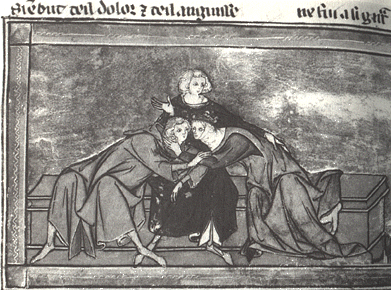

In the Medieval Period, people usually made their own clothes, either spinning & weaving the cloth themselves, or buying linen in large amounts and making up garments as they were needed. Wool was the most common textile and was often woven with goat�s hair to make chamlet, a
perfect material for Medieval clothing. The wealthy might wear garments of more expensive clothes, such as linen or silk.
Medieval people often used animal products in making clothing. Leather (from livestock) was used to make shoes, belts, and straps for armor. Many leather objects were skillfully decorated with cuts, holes, or molded designs. Wearing furs from hunted animals was a sign of wealth.
Peasant women wore long dresses of rough cloth and hoods on their heads, but wealthy ladies were much more elegant (left pictures). A lady�s appearance was very important, and women were expected to dress elegantly. However, if she tried to improve her features by powdering her face, dabbing her cheeks with vermilion (which was red dye), or applying a beauty mask (of mashed beans and mare�s milk), the church frowned upon her. It was also improper for women to dye their hair or attach strands of artificial hair to their own. The wealthy ladies wore costly jewelry because it looked attractive and because it showed off their riches. Other than accessories, such as a veil, women wore basically the same outfits as men. A lady never wore a braies. Instead of her chainse being ankle-length, it covered her feet. Her surcoat was longer than a man�s and her sleeves were fuller. The fabric of her garments often dragged behind her on the floor.
In the Medieval Period, most nobles slept naked, except for a nightcap.


Men dressed quite differently then than they do now. Peasant men wore coarse tunics, leggings, and wooden clogs or shoes of thick cloth (left picture). In the later Middle Ages, the wealthy developed a taste for luxury and clothing became a symbol of how rich they were. Noblemen didn�t even dress themselves, but had the assistance of a squire. First came the braies, a loose pair of underwear made of linen and fastened by a cloth belt. Next, the chauces, woolen stockings, were pulled above the knee and kept in place by garters. An ankle-length shirt called the chainse, which had long tight sleeves, was slipped over the head. Each sleeve had no buttons and was sewn together each time the garment was worn. Over the chainse went a short-sleeved surcoat, usually made of a cotton blend of flax or wool. The neck of the surcoat was held closed by a fashionable brooch or pin. The long narrow belt tied at the waist was often fancy and expensive. In cold weather, a man of wealth wore a fur-lined tunic over his surcoat.


